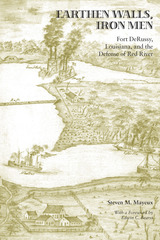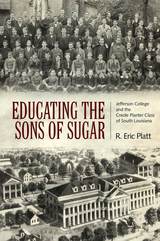3 start with E start with E

Earthen Walls, Iron Men tells the story of Fort DeRussy, Louisiana, a major Confederate fortification that defended the lower Red River in 1863-64 during the last stages of the Civil War. Long regarded as little more than a footnote by historians, the fort in fact played a critical role in the defense of the Red River region. The Red River Campaign was one of the Confederacy's last great triumphs of the war, and only the end of the conflict saved the reputations of Union leaders who had recently been so successful at Vicksburg. Fort DeRussy was the linchpin of the Confederates' tactical and strategic victory.
Steven M. Mayeux does more than just tell the story of the fort from the military perspective; it goes deeper to closely examine the lives of the people that served in-and lived around-Fort DeRussy. Through a thorough examination of local documents, Mayeux has uncovered the fascinating stories that reveal for the first time what wartime life was like for those living in central Louisiana.
In this book, the reader will meet soldiers and slaves, plantation owners and Jayhawkers, elderly women and newborn babies, all of whom played important roles in making the history of Fort DeRussy. Mayeux presents an unvarnished portrait of the life at the fort, devoid of any romanticized notions, but more accurately capturing the utter humanity of those who built it, defended it, attacked it, and lived around it.
Earthen Walls, Iron Men intertwines the stories of naval battles and military actions with those human elements such as greed, theft, murder, and courage to create a vibrant, relevant history that will appeal to all who seek to know what real life was like during the Civil War.
Steve Mayeux is a graduate of LSU and a former Marine officer. His work as an agricultural consultant in the central Louisiana area for the past thirty years has given him a great appreciation for the history and geography of the lower Red River.

The education of individual planter classes—cotton, tobacco, sugar—is rarely treated in works of southern history. Of the existing literature, higher education is typically relegated to a footnote, providing only brief glimpses into a complex instructional regime responsive to wealthy planters. R. Eric Platt’s Educating the Sons of Sugar allows for a greater focus on the mindset of French Creole sugar planters and provides a comprehensive record and analysis of a private college supported by planter wealth.
Jefferson College was founded in St. James Parish in 1831, surrounded by slave-holding plantations and their cash crop, sugar cane. Creole planters (regionally known as the “ancienne population”) designed the college to impart a “genteel” liberal arts education through instruction, architecture, and geographic location. Jefferson College played host to social class rivalries (Creole, Anglo-American, and French immigrant), mirrored the revival of Catholicism in a region typified by secular mores, was subject to the “Americanization” of south Louisiana higher education, and reflected the ancienne population’s decline as Louisiana’s ruling population.
Resulting from loss of funds, the college closed in 1848. It opened and closed three more times under varying administrations (French immigrant, private sugar planter, and Catholic/Marist) before its final closure in 1927 due to educational competition, curricular intransigence, and the 1927 Mississippi River flood. In 1931, the campus was purchased by the Society of Jesus (Jesuits) and reopened as a silent religious retreat. It continues to function to this day as the Manresa House of Retreats. While in existence, Jefferson College was a social thermometer for the white French Creole sugar planter ethos that instilled the “sons of sugar” with a cultural heritage resonant of a region typified by the management of plantations, slavery, and the production of sugar.

New Orleans has always captured our imagination as an exotic city in its racial ambiguity and pursuit of les bons temps. Despite its image as a place apart, the city played a key role in nineteenth-century America as a site for immigration and pluralism, the quest for equality, and the centrality of self-making.
In both the literary imagination and the law, creoles of color navigated life on a shifting color line. As they passed among various racial categories and through different social spaces, they filtered for a national audience the meaning of the French Revolution, the Haitian Revolution of 1804, the Civil War and Reconstruction, and de jure segregation.
Shirley Thompson offers a moving study of a world defined by racial and cultural double consciousness. In tracing the experiences of creoles of color, she illuminates the role ordinary Americans played in shaping an understanding of identity and belonging.
READERS
Browse our collection.
PUBLISHERS
See BiblioVault's publisher services.
STUDENT SERVICES
Files for college accessibility offices.
UChicago Accessibility Resources
home | accessibility | search | about | contact us
BiblioVault ® 2001 - 2024
The University of Chicago Press









